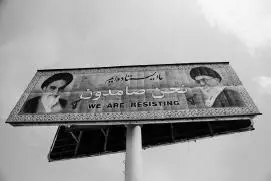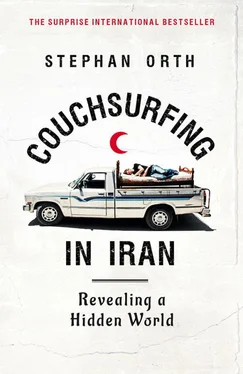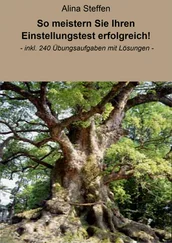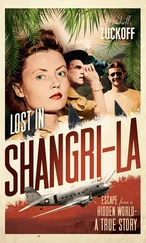On the ground in front of the entrance are paintings of the Israeli and American flags, and the latter is so faded that it is hardly recognizable. “Everyone who enters has to tread on them,” explains Yasmin. You have to make a detour to avoid them. The choice of the blue Star of David as a doormat is surprising, as during the war Israel supplied antitank missiles and Uzi machine guns to Iran. The propaganda machinery nowadays doesn’t want anything to do with that. For them Israel was always allied with Iraq.
A former commander of the Iranian troops, who introduces himself as Ali Sorkheh, guides us through the trail of the memorial. “Everyone should know the truth about the battlefields,” says the muscular fifty-seven-year-old with a hoarse voice. He is wearing sunglasses, and has white stubble and “Prima” sneakers. He’s been a guide for twenty-three years. “During Operation Fath ol-Mobin, 3,000 Iranian and 25,000 Iraqi soldiers died here, and 50,000 were captured.” And already, discovering the truth about the battlefields is not as simple as it seems. His numbers are exaggerated. According to independent estimates of the Center for Strategic and International Studies, some 5,000 Iranian soldiers died, while 14,000 Iraqi soldiers died or were taken prisoner during Operation Fath ol-Mobin. Sorkheh picks up a cartridge case. “Saddam,” he murmurs. “Many of us still have these things in our bodies.”
I ask him whether he has any war wounds. “My lungs are ruined from mustard gas. Germany supplied Iraq with chemical weapons.”
The hilly surroundings of clay soils and individual shrubs seem very dreary, as they consist mainly of two colors, light brown and green, exactly like the camouflaged tanks of which only the wrecks remain. As if to add a bit of color, a few places show posters of mutilated bodies, portraits of teenage martyrs, or shots of ayatollahs Khamenei or Khomeini next to patriotic slogans: It was a war of Truth against Lies or The greatest victims are the families of the martyrs.
Sorkheh shows us a hidden Iraqi bunker. “Exactly the same kind of bunkers as the Israelis built on the Golan Heights.” For him this is evidence that the Israeli military advisers were supporting the Iraqis.
The most striking building on the compound is the “Tomb of the Eight Unknown Soldiers,” which is still unfinished—a rectangular mud brick construction with a white tower whose stepped spires look like a ladder to heaven. At the entrance Sorkheh places his right hand on his heart and bows, then goes around laying his hand for a moment on the tombstone of each of the eight graves fixed to the ground in two rows of four. “No identification tags were found for these martyrs,” he says. Only the date of death and the battle are mentioned. Karbala 5, Ramedan, Val Fadj 8. Val Fadj means dawn, the time when the Iranians began most of their assaults. Yasmin points to a red bandana hanging on the wall.
Ya Hussein is printed on it. “This was the chant before every battle: ‘In the name of Imam Hussein,’” says Yasmin. The grandson of the Prophet Muhammad died 1,300 years ago, after being ambushed at Karbala. Every year, during the sacred month of Muharram , Shiites mourn their ancient martyr, and Karbala in Iraq is still their holiest pilgrimage site. Hussein is also supposed to be the guardian of the virgin Paradise reserved for victims of war. So, Ya Hussein is the Persian variation of Morituri te salutant .
When the neighboring countries finally agreed on a ceasefire in August 1988, the borders were exactly as they had been before the war. “The Iraqis built 150 miles of roads in six months in Khuzestan,” says former commander Sorkheh. “That was the only good that came out of the war.”
The next day one of these roads takes us to the groves of crownless date palms some seventy-five miles south of Ahvaz. Tens of thousands of tree trunks rise skyward, nothing remaining of the crowns but a few charcoaled leaf fronds. They have been there for more than twenty-five years, disfigured, lifeless, like a paralyzed ghost army guarding for all eternity the mud-colored plains of Khuzestan, the most valuable province, but surely not the most beautiful.
“These are the ‘trees of resistance,’” explains Yasmin. “Saddam had them all torched because they could have been used as cover by the Iranian soldiers. The trees died but didn’t fall, which is why they became a symbol of our fighting spirit and pride. Not one of them has been felled since the war.” Martyrs are particularly venerated in Iran, even if they are trees.
Ahmad Mahmoudi drags his left leg; he still has two bullets in his thigh, and he had four in his arm. He knows what it feels like to face a volley of bullets, and the sound of a tank shell exploding a few feet away. It is a miracle that he is still living. The dark-skinned forty-nine-year-old in military uniform is standing on a wooden jetty on the banks of the Shatt al-Arab and talks about the war to a group of more than twenty black-veiled tourists.
The jetty looks as if it were once a ferry terminal, but no ship crosses these waters. The border river Shatt al-Arab was one of the reasons Saddam Hussein invaded Iran. It is Iraq’s only waterway to the Persian Gulf and particularly valuable for merchant ships, and he no longer wanted to share this with his neighbors. We are in the town of Arvand Kenar, and looking across the river you can see Iraq, four miles as the crow flies to the town of Faw. We can see a blue mosque dome, transmission towers and minarets, a few old-fashioned dhows. Conspicuous No Swimming signs and steel tank traps ensure that no one gets silly ideas. From the moment of our arrival we notice that our presence is making the soldiers nervous. One asks if he can photograph me. “You are the first non-Muslim visitor here,” he says. Then he wants to know what I’m doing here.
“I’m a tourist and very interested in the Iran-Iraq War,” I answer. Initially, he seems to be satisfied, but he is never more than fifteen feet away from me and always snapping away on his digital camera.

The most striking exhibits in the open-air war museum are the naval boats and the heavy artillery, and a twenty-foot-long metal tube with a kind of cartoon on it. The colored illustration shows how soldiers made a pontoon out of five thousand such tubes, which was strong enough to carry tanks to the opposite bank. Above it stands a gigantic billboard at least fifty feet wide showing the two bearded Supreme Leaders, Khomeini and Khamenei. It is pointing toward the bank. On it the message WE ARE RESISTING can be read by anyone on the Iraqi side with a pair of binoculars.
The Iranians consider it a triumph to have driven back the invaders, even if, in truth, like in most wars, there was no winner.
No one knows the four-mile stretch of water to Iraq better than the veteran Ahmad Mahmoudi. Three armed soldiers form a circle around us as he tells us his story. “I was with the Basij paramilitary volunteer militia. Every night at about ten o’clock I snorkeled to the Iraqi bank to spy out assault targets. Two hours across, two hours back, despite waves and current. The enemy had radar, watchtowers, machine guns, and minefields, and they were armed to the teeth. Our strongest weapon was our belief in God, and we were never noticed. I wasn’t afraid; I was prepared to die.” Mahmoudi smiles a lot, and he smiles proudly when he is giving his account. He plays the role of war hero perfectly, as he already has done hundreds of times—an ideal person for the job of a line-toeing tourist guide. Behind him, a passenger ship rattles by, full speed to the Persian Gulf, as if trying to leave the former war zone behind as quickly as possible.
Читать дальше




![Stephan Orth - Behind Putin's Curtain - Friendships and Misadventures Inside Russia [aka Couchsurfing in Russia]](/books/415210/stephan-orth-behind-putin-s-curtain-friendships-a-thumb.webp)








